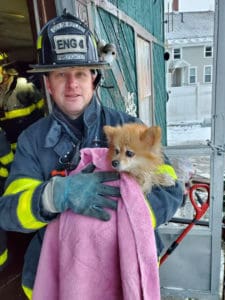By Katy Savage
Local public service departments are busier than ever and some can’t find enough volunteers.
Rutland City Fire Chief William Lovett said his department is fully staffed with 27 full-time firefighters, but the volume of calls has increased since the pandemic, putting a strain on public service departments that were already struggling with staffing shortages before the pandemic.

Firefighter Dave Werbinski with a fam- ily dog that was saved from a fire at 30 Forest St. in January this year.
“People were homebound with Covid and were likely to catch a problem at their house before it came to flames coming out their windows,” Lovett said.
Lovett said public scrutiny combined with the number of hours it requires to get certified has made public service work unattractive.
“There’s a lot of time away from your families,” Lovett said. “The hours are long and the work tends to be difficult.”
The shortages aren’t just in the fire department. There also aren’t enough first responders.
Like other fire departments, Rutland City has been assisting the short-staffed Regional Ambulance Service with more calls since the pandemic started.
“A lot of fire departments around the area are doing what they can just to help out,” Lovett said.
The city department responded to 75 EMS calls in 2021, up from 39 in 2020.
Jim Finger, the chief executive administrator for Regional Ambulance Service, said part of the problem with hiring new people stems from training being canceled during the pandemic.
“It’s just everything coming together — everybody across the nation is working hard to resolve the problem,” he said.
Finger, who is also president of the Vermont Ambulance Association, said calls initially decreased at the beginning of the pandemic, but now Regional Ambulance is responding to 20-25% more calls compared to pre-Covid.
“I think that’s because people were not treated for a year and now they’re paying the consequences somewhat,” Finger said.
Regional Ambulance responds to an average of 10,000 calls a year and serves 12 towns in Rutland County. There are a total of 70 employees — most of whom are per-diem and part time.
Finger said it can take as little as 24 hours for a first responder to be certified to as many as 2,000 hours to become a paramedic.
Finger said he’s been on Zoom calls with senators and other public officials to find a solution. Some departments have increased wages to combat the shortage. Woodstock Fire/EMS shifted from a volunteer department to paid two years ago to entice more people to respond to daytime calls.
Woodstock Fire Chief David Green said he has 10 full-time employees as well as about 20 volunteers who respond to about 1,000 to 1,200 fire and EMS calls a year, but he’s always in need of more volunteers.
Woodstock has a budget of around $1.4 million and each firefighter is paid an average of $48,000 a year, Green said.
Green said EMS calls are down slightly while fire calls have been steady the past two years.
“People with the broken toe really didn’t want to go to the hospital,” he said. “We’re slowly trending back up again.”
Killington Fire recently held a recruiting event, which Killington Fire Warden Tom Rock said attracted a couple of new volunteers.
“We have picked up a couple but it takes time,” Rock said, explaining it takes at least 170 hours for a new recruit to be trained.
“I think people are maybe reprioritizing their life with Covid,” Rock said. “People are staying home.”
Rock said the average person is also busier.
“In today’s economy, a lot of people work second jobs,” he said.




